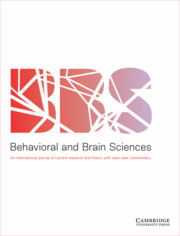Crossref Citations
This article has been cited by the following publications. This list is generated based on data provided by
Crossref.
Anselme, Patrick
2019.
Do Religious Practices and Foraging Behavior Have a Common Motivational Basis?.
Evolutionary Psychological Science,
Vol. 5,
Issue. 2,
p.
231.
Strand, Paul S.
Vossen, Jordan J.
and
Savage, Erinn
2019.
Culture and Child Attachment Patterns: a Behavioral Systems Synthesis.
Perspectives on Behavior Science,
Vol. 42,
Issue. 4,
p.
835.
van Horik, Jayden O.
Beardsworth, Christine E.
Laker, Philippa R.
Langley, Ellis J.G.
Whiteside, Mark A.
and
Madden, Joah R.
2019.
Unpredictable environments enhance inhibitory control in pheasants.
Animal Cognition,
Vol. 22,
Issue. 6,
p.
1105.
Nettle, Daniel
and
Bateson, Melissa
2019.
Food-Insecure Women Eat a Less Diverse Diet in a More Temporally Variable Way: Evidence from the US National Health and Nutrition Examination Survey, 2013-4.
Journal of Obesity,
Vol. 2019,
Issue. ,
p.
1.
Godsell, Sarah
Randle, Michael
Bateson, Melissa
and
Nettle, Daniel
2019.
Food Insecurity Moderates the Acute Effect of Subjective Socioeconomic Status on Food Consumption.
Frontiers in Psychology,
Vol. 10,
Issue. ,
Gozli, Davood
2019.
Experimental Psychology and Human Agency.
p.
41.
Tiba, Alexandru
2020.
Embodied Hot Cognitive Vulnerability to Emotional Disorders.
p.
139.
Seidenbecher, Sophie E.
Sanders, Joshua I.
von Philipsborn, Anne C.
Kvitsiani, Duda
and
Skoulakis, Efthimios M. C.
2020.
Reward foraging task and model-based analysis reveal how fruit flies learn value of available options.
PLOS ONE,
Vol. 15,
Issue. 10,
p.
e0239616.
Zack, Martin
St. George, Ross
and
Clark, Luke
2020.
Dopaminergic signaling of uncertainty and the aetiology of gambling addiction.
Progress in Neuro-Psychopharmacology and Biological Psychiatry,
Vol. 99,
Issue. ,
p.
109853.
Marshall, Andrew T.
Munson, Christy N.
Maidment, Nigel T.
and
Ostlund, Sean B.
2020.
Reward-predictive cues elicit excessive reward seeking in adolescent rats.
Developmental Cognitive Neuroscience,
Vol. 45,
Issue. ,
p.
100838.
Fuentes-Verdugo, Esmeralda
Pellón, Ricardo
Papini, Mauricio R.
Torres, Carmen
Fernández-Teruel, Alberto
and
Anselme, Patrick
2020.
Effects of partial reinforcement on autoshaping in inbred Roman high- and low-avoidance rats.
Physiology & Behavior,
Vol. 225,
Issue. ,
p.
113111.
Fennis, Bob M.
Gineikiene, Justina
Barauskaite, Dovile
and
van Koningsbruggen, Guido M.
2020.
Nudging health: Scarcity cues boost healthy consumption among fast rather than slow strategists (and abundance cues do the opposite).
Food Quality and Preference,
Vol. 85,
Issue. ,
p.
103967.
Tiba, Alexandru
2020.
Embodied Hot Cognitive Vulnerability to Emotional Disorders.
p.
105.
Zhang, Xinyu
Wang, Xue
Wang, Wei
Xu, Renxin
Li, Chunlin
and
Zhang, Feng
2021.
Effects of Personality Traits on the Food-Scratching Behaviour and Food Intake of Japanese Quail (Coturnix japonica).
Animals,
Vol. 11,
Issue. 12,
p.
3423.
Anselme, Patrick
2021.
Effort-motivated behavior resolves paradoxes in appetitive conditioning.
Behavioural Processes,
Vol. 193,
Issue. ,
p.
104525.
Bentall, Richard P.
Lloyd, Alex
Bennett, Kate
McKay, Ryan
Mason, Liam
Murphy, Jamie
McBride, Orla
Hartman, Todd K.
Gibson-Miller, Jilly
Levita, Liat
Martinez, Anton P.
Stocks, Thomas V. A.
Butter, Sarah
Vallières, Frédérique
Hyland, Philip
Karatzias, Thanos
Shevlin, Mark
and
Sudzina, Frantisek
2021.
Pandemic buying: Testing a psychological model of over-purchasing and panic buying using data from the United Kingdom and the Republic of Ireland during the early phase of the COVID-19 pandemic.
PLOS ONE,
Vol. 16,
Issue. 1,
p.
e0246339.
Bateson, Melissa
Andrews, Clare
Dunn, Jonathon
Egger, Charlotte B.C.M.
Gray, Francesca
Mchugh, Molly
and
Nettle, Daniel
2021.
Food insecurity increases energetic efficiency, not food consumption: an exploratory study in European starlings.
PeerJ,
Vol. 9,
Issue. ,
p.
e11541.
Fuentes-Verdugo, Esmeralda
Pellón, Ricardo
Papini, Mauricio R.
Torres, Carmen
and
Anselme, Patrick
2021.
Partial reinforcement in rat autoshaping with a long CS: Effects of pramipexole and chlordiazepoxide on sign and goal tracking.
Psicológica Journal,
Vol. 42,
Issue. 1,
p.
85.
Ostlund, Sean B
and
Marshall, Andrew T
2021.
Probing the role of reward expectancy in Pavlovian-instrumental transfer.
Current Opinion in Behavioral Sciences,
Vol. 41,
Issue. ,
p.
106.
Chrzanowska, Anna
Modlinska, Klaudia
Goncikowska, Katarzyna
Pisula, Wojciech
and
Mettke-Hofmann, Claudia
2022.
Rat’s response to a novelty and increased complexity of the environment resulting from the introduction of movable vs. stationary objects in the free exploration test.
PLOS ONE,
Vol. 17,
Issue. 12,
p.
e0279006.



Target article
How foraging works: Uncertainty magnifies food-seeking motivation
Related commentaries (22)
A neural basis for food foraging in obesity
Beyond uncertainty: A broader scope for “incentive hope” mechanisms and its implications
Beyond “incentive hope”: Information sampling and learning under reward uncertainty
Complex social ecology needs complex machineries of foraging
Considerations for the study of “incentive hope” and sign-tracking behaviors in humans
Does the “incentive hope” hypothesis explain food-wasting behavior among humans? Yes and no
Extending models of “How Foraging Works”: Uncertainty, controllability, and survivability
Food security and obesity: Can passerine foraging behavior inform explanations for human weight gain?
Food seeking and food sharing under uncertainty
Food-seeking behavior has complex evolutionary pressures in songbirds: Linking parental foraging to offspring sexual selection
Foraging extends beyond food: Hoarding of mental energy and information seeking in response to uncertainty
Hoarding all of the chips: Slot machine gambling and the foraging for coins
Hope, exploration, and equilibrated action schemes
How uncertainty begets hope: A model of adaptive and maladaptive seeking behavior
Mechanistic models must link the field and the lab
Overlapping neural systems underlying “incentive hope” and apprehension
Random isn't real: How the patchy distribution of ecological rewards may generate “incentive hope”
Simulating exploration versus exploitation in agent foraging under different environment uncertainties
The value of uncertainty: An active inference perspective
Unpredictable homeodynamic and ambient constraints on irrational decision making of aneural and neural foragers
“How Foraging Works”: Let's not forget the physiological mechanisms of energy balance
“Incentive hope” and the nature of impulsivity in low-socioeconomic-status individuals
Author response
Incentive hope: A default psychological response to multiple forms of uncertainty